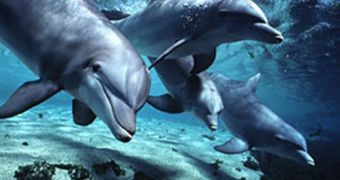People have been amazed since Antiquity by dolphins' intelligent behavior. 2,000 years ago, the Greek poet Opian said "The dolphins are humans that at the demand of the Dionysus (a Greek god) changed the ground with the sea, taking fish shape".
The high intelligence of the dolphins is regarded as a reaction to the complex marine environment. Smaller dolphins reach 35 km (22 mi) per hour but the orca or killer whale, which is in fact the world's largest dolphin, reaches 50 km (31 mi) per hour, which is a lot in the water. Due to their speeds, they can execute jumps outside the water which can be 5-6 m (16-20 ft) high and 11 m (36 ft) long in the case of the bottlenosed dolphin, the most common dolphin species.
The secret of the dolphin speed is not only connected to its hydrodynamic shape, but also to the structure of its skin, which presents an elasticity that decreases friction between its body and water. Through the decrease of the resistance, a more rapid advance is achieved for the same muscle power and energy waste.
Inside the dolphin skin, there are numerous tactile receptors which inform the brain about the "whirls" in the surrounding water, which transmits signals to the elastic cells that modify their shape so that they prevent and impede whirls' formation that would slow down the dolphin. But dolphins are also excellent divers. They can dive down to 150 m (500 ft) with ease but their ability goes down to 900 m (3,000 ft). (Beaked whales, cetaceans related to the true dolphins, can dive to 1,900 m (6,300 ft)). Their lungs, muscle and blood present adaptations that enable them to retain much more oxygen from one breath than the human being does.
Between two respirations, a dolphin's heartbeat slows down to the half, blood vessels from the muscle contract decreasing significantly the oxygen consumed by muscles, ensuring this way a reserve for the brain, which cannot miss it.
Other complex adaptations enable the dolphins to return to the surface from a deep dive without the need of taking decompression pauses, as people do for avoiding sudden nitrogen emboli that would cause death.
The dolphin's brain has the same size of a human one and displays the same complicated grooves pattern. Archaeological data show they have been having these big brains for millions of years. But there are differences between a dolphin and a human brain: in the case of the dolphin, the auditory areas are more developed than in humans (due to their complicated ultrasound sonar used for mapping the environment).
Their visual areas are less developed than in people`s case, while olfactory areas are completely absent (in humans, they are greatly reduced, but existent). But their cortex, the brain part of mental and cognitive processes, has the same size like in humans, and its surface is even more complicated and grooved than in humans. Anyhow, their intelligence and the way they perceive the world are different from ours; their world is a more acoustic one.
Dolphins can communicate, transmitting and receiving much more complex information than other animals. Some are inaudible ultrasounds, other sounds can be heard by humans, too.
In captivity, the variety of the sounds can grow and they even try to imitate the sounds of the human speech.
There were cases of dolphins which defended shipwrecked people swimming in the water from shark attacks till rescue ships appeared. And real cases of people saved from drowning by dolphins are known; this behavior is mentioned in many tales, from ancient Greek stories to the legends of the Polynesians and Maori of the New Zealand.
Sometimes they carried people more than 20 mi (32 km) to the shore. In other cases, dolphins guided fishermen lost in the mist or shipwrecked people found in boats to the shore. But dolphins do not save only people. Sometimes their behavior can seem curious: in a Florida aquarium, dolphins helped a sick shark to breathe, by pushing it to the water surface: this way they killed the shark, even if this would have helped a sick dolphin (or a shipwrecked human). The friendly relationship in some cases between dolphins and fishermen is well-known: the dolphins urge the fish to the fishermen's nets and this eases their own hunting.
The case of the "Pelorus Jack" is a famous one: a dolphin which, between 1887 and 1912, helped ships cross safely the Cook Strait, between the two main islands of the New Zealand, which are dangerous due to submarine rocks and currents.
It is curious that the dolphins never attack humans, even if just a fluke blow or bite would be enough. They can even attach affectively to some humans. But their excessive hunting (like the infamous Japanese dolphin hunt), overfishing and massive development of the navigation deplete many populations.

 14 DAY TRIAL //
14 DAY TRIAL //